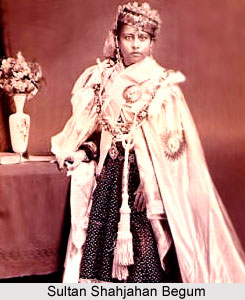 Sultan Shahjahan Begum, Knight Grand Commander was the ruler or Begum of the princely state of Bhopal. She reigned over the state at two separate occasions, first from 1844 to 1860 and her second rule was during the period 1868 to 1901. Shahjahan Begum was born on July 29th, 1838 in Islamnagar, located near the city of Bhopal. She was the only surviving child of Jahangir Mohammed Khan and his wife Sikandar Begum, Nawab of Bhopal by correct title. She was acknowledged as ruler of the princely state of Bhopal in the year 1844, when she was merely 6 years of age. During her minority, her mother Sikandar Begum became regent and took charge of the royal throne. But in 1860, the British East India Company recognised Sikandar Begum as the ruler of Bhopal in her own right, which set aside Shahjahan. In the year 1868, Sultan Shahjahan Begum became the Begum of Bhopal by succeeding her mother after her death.
Sultan Shahjahan Begum, Knight Grand Commander was the ruler or Begum of the princely state of Bhopal. She reigned over the state at two separate occasions, first from 1844 to 1860 and her second rule was during the period 1868 to 1901. Shahjahan Begum was born on July 29th, 1838 in Islamnagar, located near the city of Bhopal. She was the only surviving child of Jahangir Mohammed Khan and his wife Sikandar Begum, Nawab of Bhopal by correct title. She was acknowledged as ruler of the princely state of Bhopal in the year 1844, when she was merely 6 years of age. During her minority, her mother Sikandar Begum became regent and took charge of the royal throne. But in 1860, the British East India Company recognised Sikandar Begum as the ruler of Bhopal in her own right, which set aside Shahjahan. In the year 1868, Sultan Shahjahan Begum became the Begum of Bhopal by succeeding her mother after her death.
Rule of Sultan Shahjahan Begum
Sultan Shahjahan Begum of Bhopal was influential in commencing the construction of the Taj-ul-Masajid at Bhopal, which is one of the principal mosques in the country. But the construction of the mosque remained incomplete due to her death and was abandoned later. Later in the year 1971, work on the mosque resumed again. She built the Taj Mahal palace at Bhopal as well. The Begum of Bhopal also made generous donations for the construction of a mosque at Woking, Surrey in the United Kingdom. Shahjahan also contributed munificently towards the establishment of the Muhammadan Anglo-Oriental College at Aligarh. It later improved and became the Aligarh Muslim University.
Sultan Shahjahan Begum of Bhopal financed the cost of a railway to be constructed between Bhopal and Hoshangabad. She was also a well learned and pious lady who composed numerous books and literary works in Urdu.
Personal Life of Sultan Shahjahan Begum
In the year 1855, Sultan Shahjahan Begum was married to Baqi Muhammad Khan. She became the 3rd wife of the nobleman from Bhopal. After his death in 1867, she got married to Nawab Sadiq Hasan Khan of Qanuj, in the United Provinces. The couple had no children. Shahjahan Begum died on June 16th, 1901 in Bhopal. Her only surviving daughter from her first marriage, Kaikhusrau Jahan, succeeded her and became the Nawab Begum of Bhopal.
Titles of Sultan Shahjahan Begum
Sultan Shahjahan Begum GCSI CI KIH of Bhopal held many titles through out her are, such as-
* Nawabzadi Sultan Shah Jahan Begum Sahiba (1838- 1844)
* Her Highness Nawab Sultan Shah Jahan Begum Sahiba, Nawab Begum of Dar-ul-Iqbal-i-Bhopal (1844- 1860)
* Wali Ahad Bahadur Nawabzadi Sultan Shah Jahan Begum Sahiba (1860- 1868)
* Her Highness Nawab Sultan Shah Jahan Begum Sahiba, Nawab Begum of Dar-ul-Iqbal-i-Bhopal (1868- 1872)
* Her Highness Nawab (title Sultan Shah Jahan Begum Sahiba, Nawab Begum of Dar-ul-Iqbal-i-Bhopal, GCSI (1872- 1877)
* Her Highness Nawab Sultan Shah Jahan Begum Sahiba, Nawab Begum of Dar-ul-Iqbal-i-Bhopal, GCSI, KIH (1877- 1878)
* Her Highness Nawab Sultan Shah Jahan Begum Sahiba, Nawab Begum of Dar-ul-Iqbal-i-Bhopal, GCSI, KIH, CI (1878- 1901)
Honours of Sultan Shahjahan Begum
Sultan Shahjahan Begum was honoured a number of times by the British Government. These are mentioned below-
* Knight Grand Commander of the Order of the Star of India- GCSI (1872)
* Kaiser-i-Hind Medal- KIH (1877)
* Companion of the Order of the Crown of India- CI (1878)
* Order of Nobility, 1st Class in brilliants of the Ottoman Empire (1892)
* Queen Victoria Diamond Jubilee Medal (1897)



















